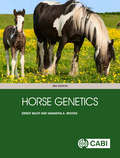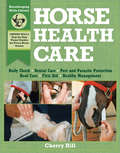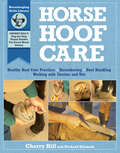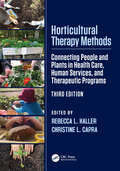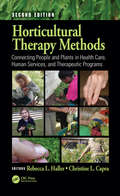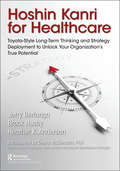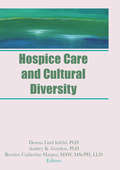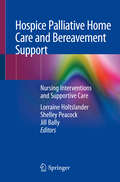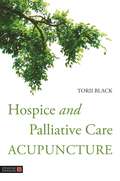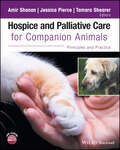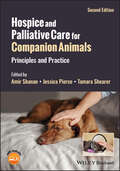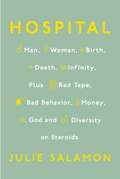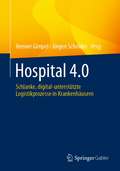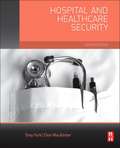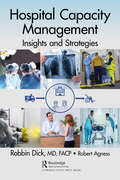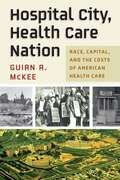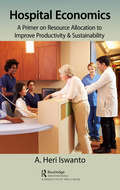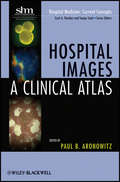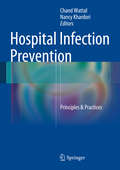- Table View
- List View
Horse Genetics
by Ernest Bailey Samantha A BrooksThis essential textbook describes the basic genetics of the horse including coat colour, parentage, medical and population genetics, cytogenetics, performance, breeding systems and genetic conservation, and new advances such as micro-satellite testing. The authors have updated Dr. Ann T. Bowling's seminal work in light of the sequencing of the complete horse genome, and in addition to the basic genetic principles and their specific applications to the horse, new and revised topics include the development of genomics, gene expression, the relationship of the genome to physiological function, blood groups, transfusion medicine and haemolytic disease of newborn foals. It also includes a greater description of the diversity of breeds of horse in the world, and equid evolution. It is an essential book for students of equine studies, animal breeding and veterinary science, as well horse breeders and owners.
Horse Genetics
by Ernest Bailey Samantha A BrooksCompletely updated and revised, the third edition of this essential textbook describes the basic genetics of the horse including coat colour, parentage, medical and population genetics, cytogenetics, performance, breeding systems and genetic conservation, as well as the many recent advances in genomics. New for the third edition: - More information on genomics and biology have been included - There are two additional chapters on genetics with respect to infectious diseases and reproduction - Expanded sections on quantitative genetics and genomic selection provide comprehensive coverage - Many new figures further illustrate key points in the text - Redesigned in colour throughout and keeping the popular features of previous editions This authoritative text remains one of the key sources of information for basic genetic principles and their specific applications to the horse, and is essential for students of equine studies, animal breeding and veterinary science, as well as horse breeders and owners.
Horse Health Care: A Step-By-Step Photographic Guide to Mastering Over 100 Horsekeeping Skills (Horsekeeping Skills Library)
by Cherry Hill Richard KlimeshA healthy horse is a happy horse. Packed with dozens of essential health care skills every horse owner should know, this guide will help you keep your animal healthy, save you money, and make your horse operation more self-sufficient. Cherry Hill provides illustrated step-by-step instructions for routine medical maintenance like hoof care, dental exams, and checking vital signs, while also showing you how to deal with an injured horse and the correct techniques for treating wounds, giving injections, wrapping a leg, and preventing infection.
Horse Hoof Care: Healthy Hoof Care Practices, Horseshoeing, Hoof Handling, Working With Farriers And Vets
by Cherry Hill Richard KlimeshHelp your horse put his best foot forward! Stressing the critical importance of hoof care to your horse’s overall health, this guide covers all aspects of proper hoof maintenance — from dealing with lost shoes, cracks, and thrush to promoting healthy hooves through a balanced diet. With in-depth discussions of hoof anatomy, the role of the farrier, and the importance of daily routines, Horse Hoof Care provides everything you need to know to give your horse a solid foundation of healthy, strong hooves.
Horse Owner's Guide to Toxic Plants: Identifications, Symptoms, and Treatments
by Sandra McQuinnHorse Owner's Guide to Toxic Plants is a must-have, exclusive reference book for all horse owners, and the first of its kind on the subject of equines and plants. Keep this book in the medicine cabinet in the barn. Walk around the pastures with the book in hand, especially in late spring or early summer. Or pack it with on a trail ride. It just might save your horse's life.Horse Owner's Guide to Toxic Plants is organized according to types of plants—trees, bushes, shrubs, and vines, ferns and plants, weeds and wildflowers, and grasses and horsetails. Since visuals are very important for correct identification, clear color photographs are shown, including wherever possible a close-up photograph and line drawing to better identify each plant. Horsewoman Sandra McQuinn has researched and compiled information on more than 100 more common but toxic plants that grow in backyards, pastures, and on the range and trail. Also included is advice from a veterinarian on how to recognize the symptoms of poisonings in your horse and what steps you or your own veterinarian should take if you suspect your horse has eaten a toxic plant. Brimming with pertinent information and expert advice, Horse Owner's Guide to Toxic Plants is a must-have for all equine aficionados. No horse owner should be without it, including those who board their horses.
Horse Secrets
by A. S. AlexanderDr. A. S. Alexander, the writer and compiler of &“Horse Secrets,&” has had upward of 25 years&’ experience in matters pertaining to agriculture, horse breeding, veterinary science, press writing and teaching. He was the author of the first stallion service legislation and inspection regulation in America, the first law of the kind having been written by him and enacted by the Wisconsin Legislature in 1905. Similar legislation now is in force in some 16 other states, and it is accomplishing much for the improvement of horse breeding. Horse trading offers unusual opportunities and temptations for sharp practises. Both buyer and seller equally need to be horse-wise and alert. Dishonesty is discountenanced in the great horse markets, but it is common among scalpers, &“gyps&” and small traders outside of the recognized markets and is likely to be practised by either the buyer or the seller. The items published in these pages disclose many sharp practises which, aside from their interest as facts not generally known, are valuable as information for the man who would engage intelligently in horse buying and selling. The writer and publishers of this book desire to expose these tricks, and to decry their practise in the markets and among outside dealers and breeders. &“Forewarned is forearmed,&” and the information here given will doubtless save many a man from loss, and tend to make dishonesty less rife because less likely to succeed. In mentioning the various tricks herein disclosed, the exact methods have not been given in detail. We have no desire to instruct readers so that they may &“go and do likewise&”; for the same reason doses have not been given for the administration of the various drugs and &“dopes&” used by tricksters.
Horse Senses (Manson Ser.)
by Susan McBaneHorses perceive the world differently from humans because their senses developed differently through evolution to cope with different ways of living and surviving. Horses are essentially prey/flight animals. The horse's senses therefore determine how the world appears to him and how he reacts to it. As the horse's perception and understanding are v
Horse and Stable Management
by Sarah Pilliner Zoe Davies Jeremy Houghton BrownSince the first edition was published in 1984 Horse and Stable Management has become the recognised source of reliable information on all aspects of the practical management of horses and ponies. It is now the established textbook for everyone who owns a horse or works with horses. This fourth edition has been radically revised and reorganised to include the most up-to-date and accurate procedures and advice. With many new photographs, Horse and Stable Management includes chapters covering evolution and behaviour, conformation and action, routine preventive measures, nursing the sick horse, first aid, lameness and the management of breeding stock. Horse and Stable Management is essential reading for those taking British Horse Society and Association of British Riding Schools examinations as well as those taking college equine courses or National Vocational Qualifications in horse care and management. The Authors Jeremy Houghton Brown was manager of the British National Equestrian Centre and the British Racing School, then for many years principal lecturer in equine studies at Warwickshire College, where he started and pioneered British equine education. Above all, he is an experienced, practical horseman. Sarah Pilliner is an equine consultant specialising in horse care. She is also an experienced lecturer, competition rider, senior examiner, and the author of several books. Zoe Davies is a former lecturer in equine science, a consultant equine nutritionist, author and external examiner for higher education courses. She has substantial experience in equine management and training. From previous reviews: ‘A new classic… a clearly written and easily understood handbook.’ Riding ‘It is extremely comprehensive. It is also accurate. In fact, a most valuable book for anyone who owns a horse.’ Horse and Hound ‘The approach and contents are refreshingly different… very informative and a valuable source of reference.’ Horse and Rider
Horses in Translation
by Sharon WilsieWith her landmark first bookHorse Speak: The Equine-Human Translation Guide, trainer Sharon Wilsie upended conventional methods of human-equine communication (using words and ropes, for example) with her clear classification of the language horses use with each other (body, breath, and intent), as well as an unparalleled explanation of how we as humans can effectively mirror it. Learning to &“listen&” and &“talk&” to horses in their language, instead of expecting them to comprehend ours, is a milestone in the progressive philosophy of horsemanship, helping find positive solutions to behavior and training problems and ultimately leading to fewer misunderstandings between horses and humans.In her much anticipated follow-up, Wilsie uses true stories to relate examples of &“problems&” and how they were solved using Horse Speak. Her engaging narrative introduces readers to dozens of real life scenarios from different barns, various disciplines, and riders and handlers with contrasting experiences and backgrounds. Wilsie highlights her Horse Speak process, the clues that point to the best course of action, and the steps she takes to connect with horses that have shut down, grown confused, or become sulky or aggressive for any number of reasons. The result is a book full of incredible insight and exciting possibilities.
Horticultural Therapy Methods: Connecting People and Plants in Health Care, Human Services, and Therapeutic Programs
by Rebecca L. Haller and Christine L. CapraHorticultural Therapy Methods: Connecting People and Plants in Health Care, Human Services, and Therapeutic Programs was the first text to describe the processes and techniques used to provide horticultural therapy interventions, and the rationale for their use. The first edition was written to positively impact the professional practice of horticultural therapy and provide an array of strategies for horticultural therapy treatment. Prior to its publication, the topics had only been addressed by other allied professions but had not been specifically tailored for horticultural therapy. The second edition updated the material, added essential information on planning treatment sessions, and provided techniques to address treatment issues for mental health, physical health, vocational skills, and wellness. This third edition revises all chapter content, improves and expands appendices, adds a chapter on building relationships, provides new photos, and includes additional case examples, in addition to providing discussion questions, references, further reading, and key concepts.Horticultural Therapy Methods is a clear instructive manual that explains: The process of treatment planning in horticultural therapy Session development, including activity or task selections to meet treatment objectives Therapeutic use of self and relationship building Motivation and behavior management techniques Adaptations and modifications to enable and challenge program participants How to maximize active engagement in horticulture and cultivation of plants Treatment documentation guidelines Practical approaches for mental health and other areas of practice Horticultural Therapy Methods: Connecting People and Plants in Health Care, Human Services, and Therapeutic Programs, Third Edition, is a reference and guide for students, educators, and those using horticulture for therapeutic purposes to help construct effective treatment programs. Health care and human service professionals can use this reference in the therapy, treatment, and education of inmates, residents, patients, trainees, students and others. The aim of this book is to guide novice and experienced horticultural therapists to use accepted human service practices that are aligned with allied professions.
Horticultural Therapy Methods: Connecting People and Plants in Health Care, Human Services, and Therapeutic Programs, Second Edition
by Rebecca L. Haller Christine L. CapraHorticultural therapy has evolved from its use only by volunteer gardeners to become a recognized and respected therapeutic modality conducted by trained, registered professionals. Horticultural Therapy Methods is the first textbook to describe the processes and techniques used to provide horticultural therapy interventions and the rationale for their use. This book presents types of programs, settings, and goals in horticultural therapy. It outlines treatment planning; development of sessions to meet treatment objectives; motivation and behavior management techniques; documentation guidelines; practical approaches for wellness; and resources for activity ideas. New to this Edition: Various useful examples of horticultural therapy in practice and strategically placed tips and resources. Additions to appendix on horticultural therapy treatment strategies. New chapter on session planning. Thirty-seven photographs demonstrating horticultural therapy in practice. Additional "HT Practice" examples and tips. The book is used as a reference and a guide for students, educators, and those conducting horticultural therapy or therapeutic horticulture to guide them in constructing effective treatment programs. Health care and human service professionals use the reference in the therapy, treatment, and education of inmates, residents, patients, trainees, students, and other participants.
Hoshin Kanri for Healthcare: Toyota-Style Long-Term Thinking and Strategy Deployment to Unlock Your Organization’s True Potential
by Gerard A. Berlanga Brock C. Husby Heather K. AndersonThe best healthcare organizations have developed effective approaches to develop compelling strategic visions and strategies based on long-term thinking and continue to apply Lean principles across their organizations to create a culture of continuous improvement. Establishing effective strategies and Toyota style Hoshin Kanri enables healthcare organizations to align everyone in the organizations and creates a unique competitive advantage. This book follows a regional hospital's journey through the creation of long-term strategic goals and Toyota Style strategy deployment.
Hospice Care and Cultural Diversity
by Donna Infeld Audrey K Gordon Bernice C HarperHospice Care and Cultural Diversity captures the richness and differences that make up the United States and its culture. This book shows you the complex issues arising from work with patients of a different culture and encourages research in hospices which support culturally innovative programs. Many people are individually knowledgeable and culturally sensitive, but few hospices have systematically planned for service to culturally diverse groups. This volume identifies who is implementing organizational programs of cultural sensitivity and acknowledges the efforts of those individuals working to make hospice accessible to everyone.Hospice Care and Cultural Diversity contains original research, personal insights, and overviews to help you understand what is being done in the field. Specifically, chapters discuss: National Hospice Organization activities, goals, and recommended actions death and dying from a Native American perspective breaking barriers to hospice for African Americans a case study of the development of a culturally sensitive treatment plan in pre-hospice south Texas caregiving norms surrounding dying and use of hospice services among Hispanic American elderly cultural considerations surrounding childhood bereavement among Cambodians in the U.S. one hospice’s experience in identifying and meeting the needs of ethnic minority patientsPeople from many different cultures are eager to share their customs, practices, and beliefs. They want hospice providers to understand their culture, and they want their community served by hospice. The only book of its kind, Hospice Care and Cultural Diversity is a valuable reference and source of ideas for anyone interested in the delivery of hospice services. From students to experts, you will find much information to help make hospice care accessible and comfortable for all groups of people.
Hospice Palliative Home Care and Bereavement Support: Nursing Interventions and Supportive Care
by Lorraine Holtslander Shelley Peacock Jill BallyThis book provides an unique resource for registered nurses working in hospice palliative care at home and for the community, outside of acute care settings and also incorporates literature related to palliative care in acute health care settings, as part of the overall services and supports required. Very few resources exist which specifically address hospice palliative care in the home setting, despite the fact that most palliative care occurs outside acute care settings and is primarily supported by unpaid family caregivers. An overview of the concerns for individuals and families, as well as specific nursing interventions, from all ages would be an excellent support for nursing students and practicing registered nurses alike.The book structure begins with a description of the goals and objectives of hospice palliative care and the nursing role in providing excellent supportive care. Chapters include research findings and specifically research completed by the authors in the areas of pediatric palliative care, palliative care for those with dementia, and the needs of family caregivers in bereavement. Interventions developed by the editors are provided in this book, such as the “Finding Balance Intervention” for bereaved caregivers; the “Reclaiming Yourself” tool for bereaved spouses of partners with dementia; and The Keeping Hope Possible Toolkit for families of children with life threatening and life limiting illnesses. The development and application of these theory-based interventions are also highlighted. Videos and vignettes written by family caregivers about what was helpful for them, provide a patient-and family-centered approach.The book will benefit nursing students, educators and practicing registered nurses by providing information, theory, and evidence from research.
Hospice and Palliative Care Acupuncture
by Torii BlackA handbook for acupuncturists and healthcare practitioners on the use of acupuncture for end-of-life care. The book covers the major hospice and palliative care diagnoses from a Chinese medicine perspective, as well as grief and loss, and includes the roots of Chinese historical perspectives on death and dying. The acupuncturist is introduced to the working medical model of hospice care and the interdisciplinary team approach and provided with evidence-based strategies for the use the acupuncture in symptom management.
Hospice and Palliative Care for Companion Animals: Principles and Practice
by Jessica Pierce Amir Shanan Tamara ShearerHospice and Palliative Care for Companion Animals: Principles and Practice offers the first comprehensive reference to veterinary hospice and palliative care, with practical guidance and best practices for caring for sick and dying animals. Presents the first thorough resource to providing veterinary hospice and palliative care Offers practical guidance and best practices for caring for sick and dying animals Provides an interdisciplinary team approach, from a variety of different perspectives Gives concrete advice for easing pets more gently through their final stage of life Includes access to a companion website with client education handouts to use in practice
Hospice and Palliative Care for Companion Animals: Principles and Practice
by Jessica Pierce Amir Shanan Tamara ShearerHospice and Palliative Care for Companion Animals A thoroughly updated and expanded new edition of the only book providing comprehensive treatment of hospice and palliative care in veterinary medicine Animals with life-limiting illnesses deserve compassionate, thoughtful, end-of-life care. Their caregivers and families, faced with the loss of a beloved companion, deserve empathy, support, and education, to guide them through an emotionally wrenching period and provide their companion animals with the highest possible quality of life. In recent years, the ethics of care and service to sick and dying animals and their caregivers has been the subject of considerable attention. Hospice and Palliative Care for Companion Animals, 2nd Edition provides a thorough update to the first and only complete guide to this field of service, its foundations, and its applications. It addresses the needs of pets, caregivers, and veterinary professionals alike, including fundamental ethical and emotional principles as well as detailed discussion of specific illnesses and life-limiting conditions. The expanded second edition incorporates cutting-edge research into animal behavior and cognition to enrich the reader’s understanding of companion animals’ emotional needs and their experience of illness and death. Hospice and Palliative Care for Companion Animals, 2nd Edition readers will also find: Existing chapters expanded to incorporate new research and practical experience New chapters discussing factors underlying the decision to euthanize, the potential role of ethology in palliative care, and more A companion website with educational handouts for use in veterinary practices Hospice and Palliative Care for Companion Animals is an indispensable resource for caregivers and veterinary professionals alike.
Hospital
by Julie SalamonIn 2005, Maimonides Hospital in Brooklyn, New York, unveiled a new state-of-the-art, multimillion-dollar cancer center. Determined to understand the whole spectrum of factors that determine what kind of medical care people receive in this country, bestselling author Julie Salamon spent one year tracking the progess of the center and getting to know the characters who make the hospital run. Located in a community where sixty-seven different languages are spoken, Maimonides is a case study for the particular kinds of concerns that arise in institutions that serve an increasingly multicultural American demographic. Granted astonishing access by the hospital higher-ups, Salamon followed the doctors, patients, administrators, nurses, ambulance drivers, cooks, and cleaning staff. She explored not just the action on the ground but also the financial, ethical, technological, socioloical, and cultural matters that the hospital commuity encounters every day. Drawing on her skills as interviewer, observer, and social critic, Salamon presents the story of modern medicine. She draws out the internal and external political machinations that exist between doctors and staff as well as between hospital and community. And she grounds the science and emotion of medical drama in the financial realities of operating a huge, private institution that must contend with such issues as adapting to the specific needs of immigrant groups that make up a large and growing portion of our society. Salamon exposes struggles both profound and humdrum: bitter internal feuds, warm personal connections, comedy, egoism, greed, love, and loss; rabbinic edicts to contend with, as well as imams and herbalists and local politicians; system foul-ups, shortages of everything except forms to fill out, recalcitrant and greedy insurance reimbursement systems, and the surprising difficulty of getting doctors to wash their hands. This is the dynamic universe of small and large concerns and personalities that, taken together, determine the nature of our care.
Hospital 4.0: Schlanke, digital-unterstützte Logistikprozesse in Krankenhäusern
by Jürgen Schröder Henner GimpelDie medizinischen und pflegerischen Kernprozesse eines Krankenhauses werden durch zahlreiche Logistikprozesse unterstützt, die hohe Anforderungen an Qualität, Individualisierung, Echtzeitreaktionsfähigkeit und Kosteneffizienz stellen. Dennoch trifft man häufig auf Verschwendungen von wichtigen Ressourcen, wie Material, Fläche oder Arbeit. Schlanke Logistikprozesse sind leider eher selten. Um Logistikprozesse auf die Kernprozesse auszurichten, fokussiert sich dieses Buch auf die Weiterentwicklung von innovativen Logistiksystemen in Krankenhäusern. Hier liegt Potenzial, das durch die Digitalisierung der Logistikprozesse gehoben werden kann.Im Detail werden zwei Referenzmodelle zur „Materiallogistik“ und der „Bettenlogistik“, vorgestellt, die ein Konzept für digital-unterstützte, verschwendungsarme Logistikprozesse in Kliniken aufzeigen. Darüber hinaus werden Methoden zur Anwendung der Referenzmodelle erläutert. Diese Erkenntnisse stammen aus einem angewandten Forschungsprojekt mit zwei Krankenhäusern der maximalen Versorgungsstufe in Süddeutschland.
Hospital And Healthcare Security (Sixth Edition)
by Tony York Don MacAlisterBuilding on the foundation of the previous five editions, Hospital and Healthcare Security, 6th Edition includes new and updated chapters to reflect the current state of healthcare security, particularly in data security and patient privacy, patient-generated violence, and emergency preparedness and management. The recognized leading text in the healthcare security industry, Hospital and Healthcare Security, 6th Edition explains the basics as well as higher expertise concerns, such as the roles of design, emergency management, and policy. Conveying a wide spectrum of topics in an easy to comprehend format, Hospital and Healthcare Security, 6th Edition provides a fresh perspective for healthcare security professionals to better prepare for security issue before they occur.
Hospital Capacity Management: Insights and Strategies
by Robbin Dick Robert AgnessHospital Capacity Management: Insights and Strategies details many of the key processes, procedures, and administrative realities that make up the healthcare system we all encounter when we visit the ED or the hospital. It walks through, in detail, how these systems work, how they came to be this way, why they are set up as they are, and then, in many cases, why and how they should be improved right now. Many examples pulled from the lifelong experiences of the authors, published studies, and well-documented case studies are provided, both to illustrate and support arguments for change. First and foremost, it is necessary to remember that the mission of our healthcare system is to take care of patients. This has been forgotten at times, causing many of the issues the authors discuss in the book including hospital capacity management. This facet of healthcare management is absolutely central to the success or failure of a hospital, both in terms of its delivery of care and its ability to survive as an institution. Poor hospital capacity management is a root cause of long wait times, overcrowding, higher error rates, poor communication, low satisfaction, and a host of other commonly experienced problems. It is important enough that when it is done well, it can completely transform an entire hospital system. Hospital capacity management can be described as optimizing a hospital’s bed availability to provide enough capacity for efficient, error-free patient evaluation, treatment, and transfer to meet daily demand. A hospital that excels at capacity management is easy to spot: no lines of people waiting and no patients in hallways or sitting around in chairs. These hospitals don’t divert incoming ambulances to other hospitals; they have excellent patient safety records and efficiently move patients through their organization. They exist but are sadly in the minority of American hospitals. The vast majority are instead forced to constantly react to their own poor performance. This often results in the building of bigger and bigger institutions, which, instead of managing capacity, simply create more space in which to mismanage it. These institutions are failing to resolve the true stumbling blocks to excellent patient care, many of which you may have experienced firsthand in your own visit to your hospital. It is the hope of the authors that this book will provide a better understanding of the healthcare delivery system.
Hospital City, Health Care Nation: Race, Capital, and the Costs of American Health Care (Politics and Culture in Modern America)
by Guian A. McKeeHospital City, Health Care Nation recasts the story of the U.S. health care system by emphasizing its economic, social, and medical importance in American communities. Focusing on urban hospitals and academic medical centers, the book argues that the country’s high level of health care spending has allowed such institutions to become vital, if often problematic, economic anchors for communities. Yet that spending has also constrained possibilities for comprehensive health care reform over many decades, even after the passage of the Affordable Care Act in 2010. At the same time, the role of hospitals in urban renewal, in community health provision, and as employers of low-wage workers has contributed directly to racial health disparities.Guian A. McKee explores these issues through a detailed historical case study of Baltimore’s Johns Hopkins Hospital while also tracing their connections across governmental scales—local, state, and federal. He shows that health care spending and its consequences, rather than insurance coverage alone, are core issues in the decades-long struggle over the American health care system. In particular, Hospital City, Health Care Nation points to the increased role of financial capital after the 1960s in shaping not only hospital growth but also the underlying character of these vital institutions. The book shows how hospitals’ quest for capital has interacted with structural racism and inequality to shape and constrain the U.S. health care system. Building on this reassessment of the hospital system, its politics, and its financing, Hospital City, Health Care Nation offers ideas for the next steps in health care reform.
Hospital Economics: A Primer on Resource Allocation to Improve Productivity & Sustainability
by A. Heri IswantoThe biggest issue of economics in a hospital are the resource issues. A resource issue in hospitals creates many problems such as the excessive number of patients, poor service quality, lack of diagnostic tools and equipment, dirty and worn out facilities, long queues at the outpatient clinic, lack of drugs and other medical supplies, low employee morale, and so on. Hospital economics mention three main resource issues in as problems including; (1) Resource allocation issue, (2) Resource management issue, and (3) Generation resources issue. The main economic problem of resource allocation in hospitals are production and cost function. These two functions related to issues of equality and effectiveness of the hospital. This book specifically discusses on the aspect of hospital resource allocation by highlighting the productivity, competitiveness, cost components, economic burden of disease, and economic aspects of infectious diseases originating from the hospital. The resource management issue is related to the use of existing resources in terms of input and output. The main important economic concept is efficiency, both technical efficiency, economical, and scale, as well as the relationship between these concepts. The resource management issue highlight the economic scale, human resource development, quality development, and lean implementation. The issue of generation resources, includes how the hospital is able to get the resources to run operations without having to cover the access of stratum of community thus violating the principle of equality. This book will highlight the issue of generation resources by including a discussion of the revenue components of the hospital and the impact of DRGs.
Hospital Images
by Paul AronowitzThis gorgeous, full-color atlas and case-book presents more than sixty cases with over one hundred associated, super high-quality clinical images that a physician needs to be able to rapidly recognize and know for accurate, expedient diagnosis and treatment. The images are presented with the patient's brief medical history, followed by the diagnosis, brief discussion of the diagnosis, and the patient's clinical course and treatment. These miniature case studies encompass photos and descriptions of patients, supporting physical findings, X-rays, CT scans, electrocardiograms, blood smears, gross pathologic specimens, and microscopic pathology slides.
Hospital Infection Prevention
by Chand Wattal Nancy KhardoriThe art of medicine becomes science when supported by evidence. The recommended practices of infection prevention are based on scientific and epidemiologic evidence. However, most health care professionals see them as mandates and fail to incorporate them into their routine patient care activities. The core goal of this publication is to link the practices to the principles they are based on. The expectation is that understanding of the principles will change the practices from mandates to "should do" in the minds of health care professionals. This will lead to improvement in health care by preventing unintended harm to patients, co-workers and the communities at large. At the same time, the text provides a comprehensive, thorough and up to date information on all aspects of infection prevention in a reader-friendly manner and therefore, will serve as a valuable reference.

